CHEVROLET BLAZER 2021 Owner's Manual
Manufacturer: CHEVROLET, Model Year: 2021, Model line: BLAZER, Model: CHEVROLET BLAZER 2021Pages: 380, PDF Size: 9.1 MB
Page 281 of 380
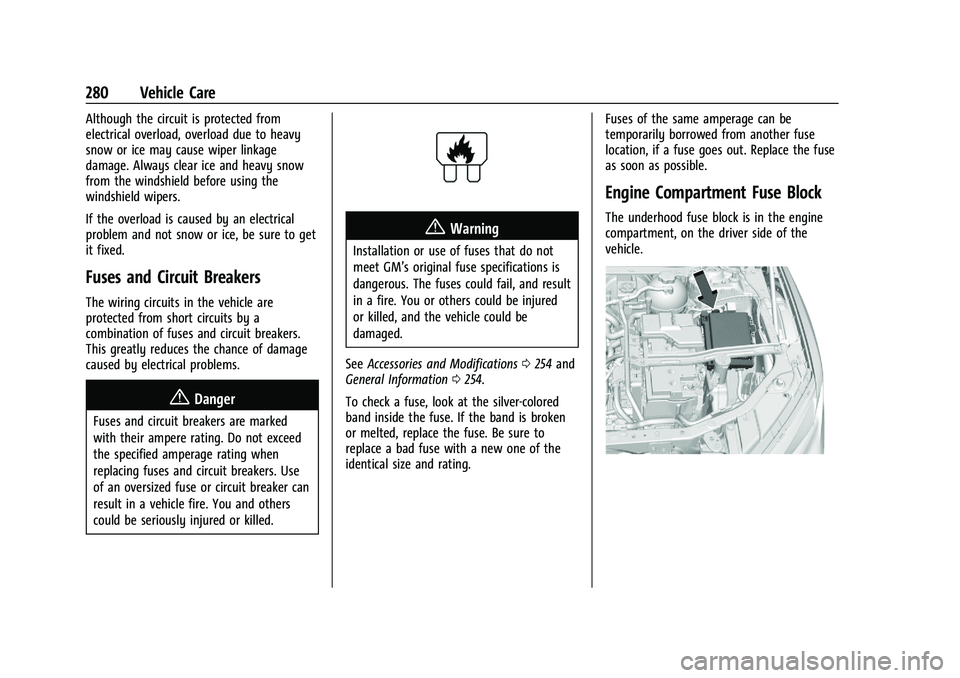
Chevrolet Blazer Owner Manual (GMNA-Localizing-U.S./Canada/Mexico-
14608203) - 2021 - CRC - 10/29/20
280 Vehicle Care
Although the circuit is protected from
electrical overload, overload due to heavy
snow or ice may cause wiper linkage
damage. Always clear ice and heavy snow
from the windshield before using the
windshield wipers.
If the overload is caused by an electrical
problem and not snow or ice, be sure to get
it fixed.
Fuses and Circuit Breakers
The wiring circuits in the vehicle are
protected from short circuits by a
combination of fuses and circuit breakers.
This greatly reduces the chance of damage
caused by electrical problems.
{Danger
Fuses and circuit breakers are marked
with their ampere rating. Do not exceed
the specified amperage rating when
replacing fuses and circuit breakers. Use
of an oversized fuse or circuit breaker can
result in a vehicle fire. You and others
could be seriously injured or killed.
{Warning
Installation or use of fuses that do not
meet GMβs original fuse specifications is
dangerous. The fuses could fail, and result
in a fire. You or others could be injured
or killed, and the vehicle could be
damaged.
See Accessories and Modifications 0254 and
General Information 0254.
To check a fuse, look at the silver-colored
band inside the fuse. If the band is broken
or melted, replace the fuse. Be sure to
replace a bad fuse with a new one of the
identical size and rating. Fuses of the same amperage can be
temporarily borrowed from another fuse
location, if a fuse goes out. Replace the fuse
as soon as possible.
Engine Compartment Fuse Block
The underhood fuse block is in the engine
compartment, on the driver side of the
vehicle.
Page 282 of 380
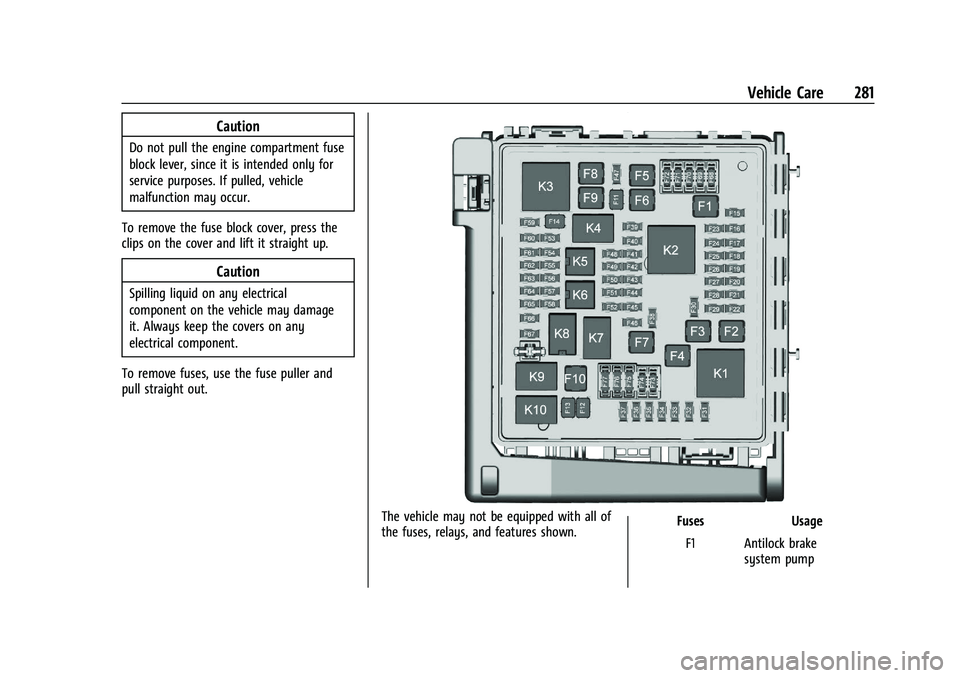
Chevrolet Blazer Owner Manual (GMNA-Localizing-U.S./Canada/Mexico-
14608203) - 2021 - CRC - 10/29/20
Vehicle Care 281
Caution
Do not pull the engine compartment fuse
block lever, since it is intended only for
service purposes. If pulled, vehicle
malfunction may occur.
To remove the fuse block cover, press the
clips on the cover and lift it straight up.
Caution
Spilling liquid on any electrical
component on the vehicle may damage
it. Always keep the covers on any
electrical component.
To remove fuses, use the fuse puller and
pull straight out.
The vehicle may not be equipped with all of
the fuses, relays, and features shown. Fuses Usage
F1 Antilock brake system pump
Page 283 of 380
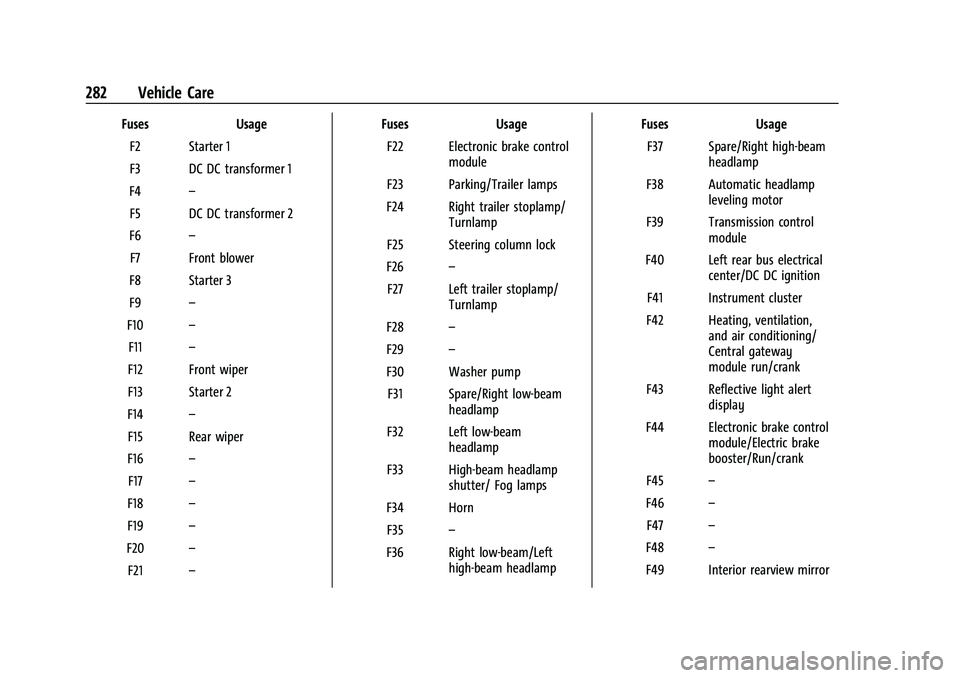
Chevrolet Blazer Owner Manual (GMNA-Localizing-U.S./Canada/Mexico-
14608203) - 2021 - CRC - 10/29/20
282 Vehicle Care
FusesUsage
F2 Starter 1
F3 DC DC transformer 1
F4 β
F5 DC DC transformer 2
F6 β
F7 Front blower
F8 Starter 3
F9 β
F10 β
F11 β
F12 Front wiper
F13 Starter 2
F14 β
F15 Rear wiper
F16 β
F17 β
F18 β
F19 β
F20 β
F21 β Fuses
Usage
F22 Electronic brake control module
F23 Parking/Trailer lamps
F24 Right trailer stoplamp/ Turnlamp
F25 Steering column lock
F26 β
F27 Left trailer stoplamp/ Turnlamp
F28 β
F29 β
F30 Washer pump F31 Spare/Right low-beam headlamp
F32 Left low-beam headlamp
F33 High-beam headlamp shutter/ Fog lamps
F34 Horn F35 β
F36 Right low-beam/Left high-beam headlamp Fuses
Usage
F37 Spare/Right high-beam headlamp
F38 Automatic headlamp leveling motor
F39 Transmission control module
F40 Left rear bus electrical center/DC DC ignition
F41 Instrument cluster
F42 Heating, ventilation, and air conditioning/
Central gateway
module run/crank
F43 Reflective light alert display
F44 Electronic brake control module/Electric brake
booster/Run/crank
F45 β
F46 β
F47 β
F48 β
F49 Interior rearview mirror
Page 284 of 380
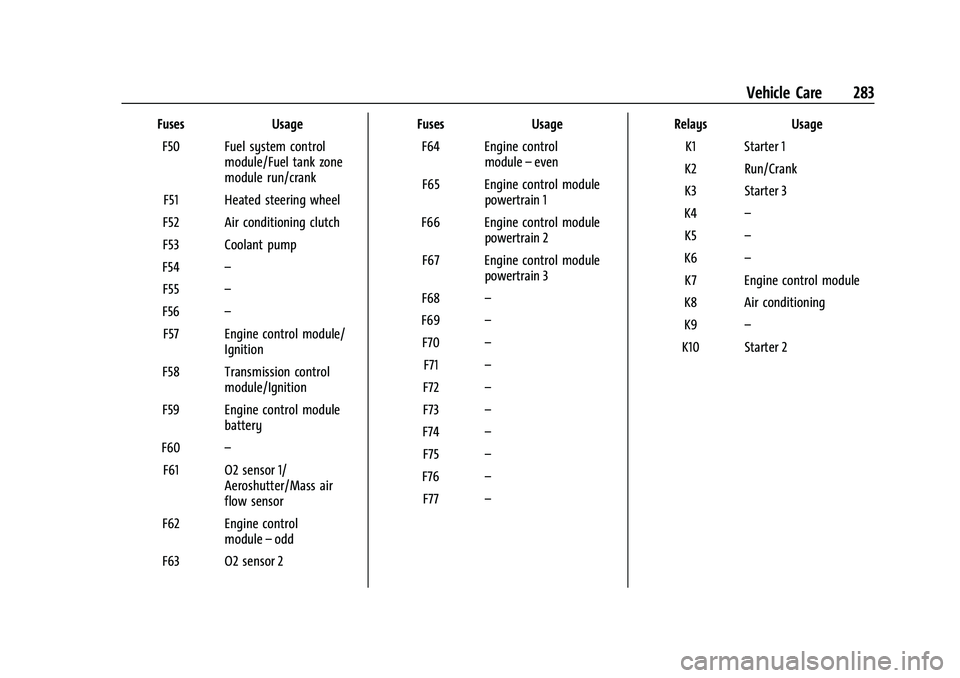
Chevrolet Blazer Owner Manual (GMNA-Localizing-U.S./Canada/Mexico-
14608203) - 2021 - CRC - 10/29/20
Vehicle Care 283
FusesUsage
F50 Fuel system control module/Fuel tank zone
module run/crank
F51 Heated steering wheel
F52 Air conditioning clutch
F53 Coolant pump
F54 β
F55 β
F56 β
F57 Engine control module/ Ignition
F58 Transmission control module/Ignition
F59 Engine control module battery
F60 β
F61 O2 sensor 1/ Aeroshutter/Mass air
flow sensor
F62 Engine control moduleβodd
F63 O2 sensor 2 Fuses
Usage
F64 Engine control moduleβeven
F65 Engine control module powertrain 1
F66 Engine control module powertrain 2
F67 Engine control module powertrain 3
F68 β
F69 β
F70 β
F71 β
F72 β
F73 β
F74 β
F75 β
F76 β
F77 β Relays
Usage
K1 Starter 1
K2 Run/Crank
K3 Starter 3
K4 β
K5 β
K6 β
K7 Engine control module
K8 Air conditioning
K9 β
K10 Starter 2
Page 285 of 380
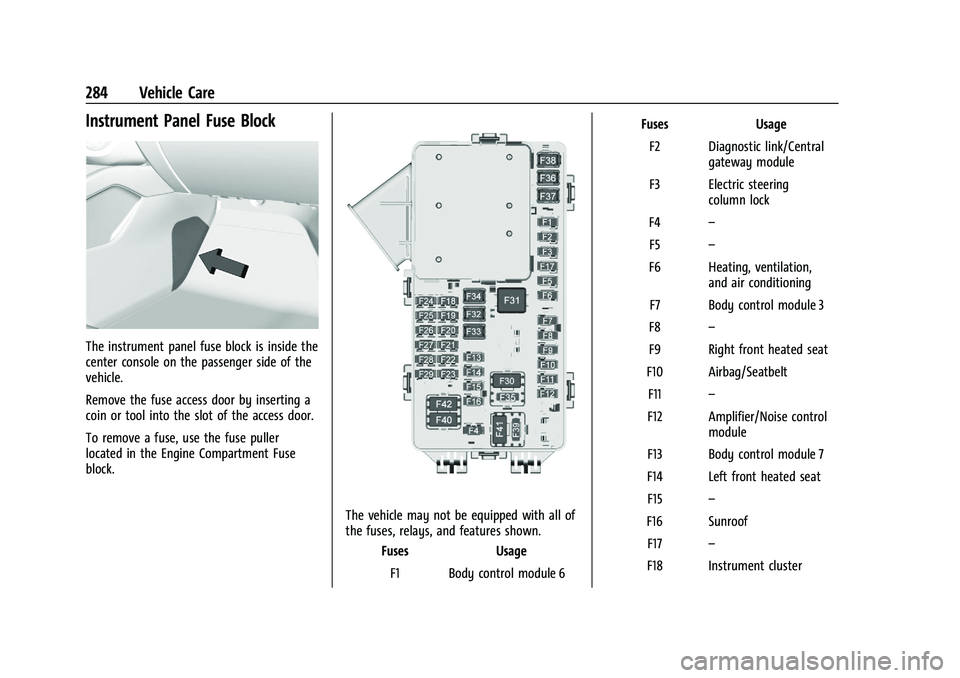
Chevrolet Blazer Owner Manual (GMNA-Localizing-U.S./Canada/Mexico-
14608203) - 2021 - CRC - 10/29/20
284 Vehicle Care
Instrument Panel Fuse Block
The instrument panel fuse block is inside the
center console on the passenger side of the
vehicle.
Remove the fuse access door by inserting a
coin or tool into the slot of the access door.
To remove a fuse, use the fuse puller
located in the Engine Compartment Fuse
block.
The vehicle may not be equipped with all of
the fuses, relays, and features shown.Fuses Usage
F1 Body control module 6 Fuses Usage
F2 Diagnostic link/Central gateway module
F3 Electric steering column lock
F4 β
F5 β
F6 Heating, ventilation, and air conditioning
F7 Body control module 3
F8 β
F9 Right front heated seat
F10 Airbag/Seatbelt F11 β
F12 Amplifier/Noise control module
F13 Body control module 7
F14 Left front heated seat F15 β
F16 Sunroof F17 β
F18 Instrument cluster
Page 286 of 380
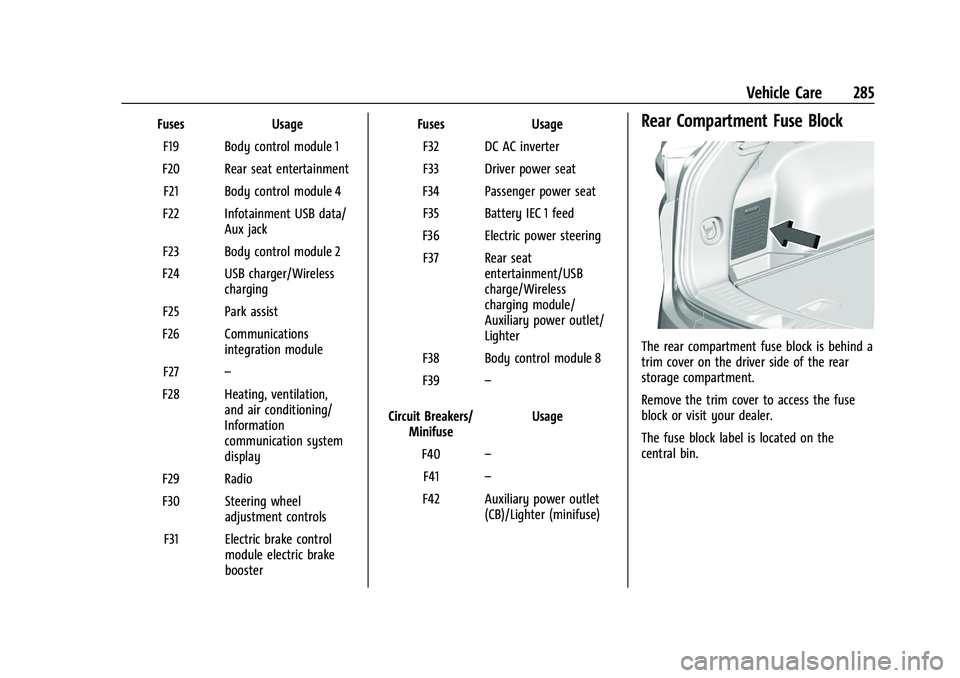
Chevrolet Blazer Owner Manual (GMNA-Localizing-U.S./Canada/Mexico-
14608203) - 2021 - CRC - 10/29/20
Vehicle Care 285
FusesUsage
F19 Body control module 1
F20 Rear seat entertainment F21 Body control module 4
F22 Infotainment USB data/ Aux jack
F23 Body control module 2
F24 USB charger/Wireless charging
F25 Park assist
F26 Communications integration module
F27 β
F28 Heating, ventilation, and air conditioning/
Information
communication system
display
F29 Radio
F30 Steering wheel adjustment controls
F31 Electric brake control module electric brake
booster Fuses
Usage
F32 DC AC inverter
F33 Driver power seat
F34 Passenger power seat F35 Battery IEC 1 feed
F36 Electric power steering F37 Rear seat entertainment/USB
charge/Wireless
charging module/
Auxiliary power outlet/
Lighter
F38 Body control module 8
F39 β
Circuit Breakers/ Minifuse Usage
F40 β
F41 β
F42 Auxiliary power outlet (CB)/Lighter (minifuse)Rear Compartment Fuse Block
The rear compartment fuse block is behind a
trim cover on the driver side of the rear
storage compartment.
Remove the trim cover to access the fuse
block or visit your dealer.
The fuse block label is located on the
central bin.
Page 287 of 380
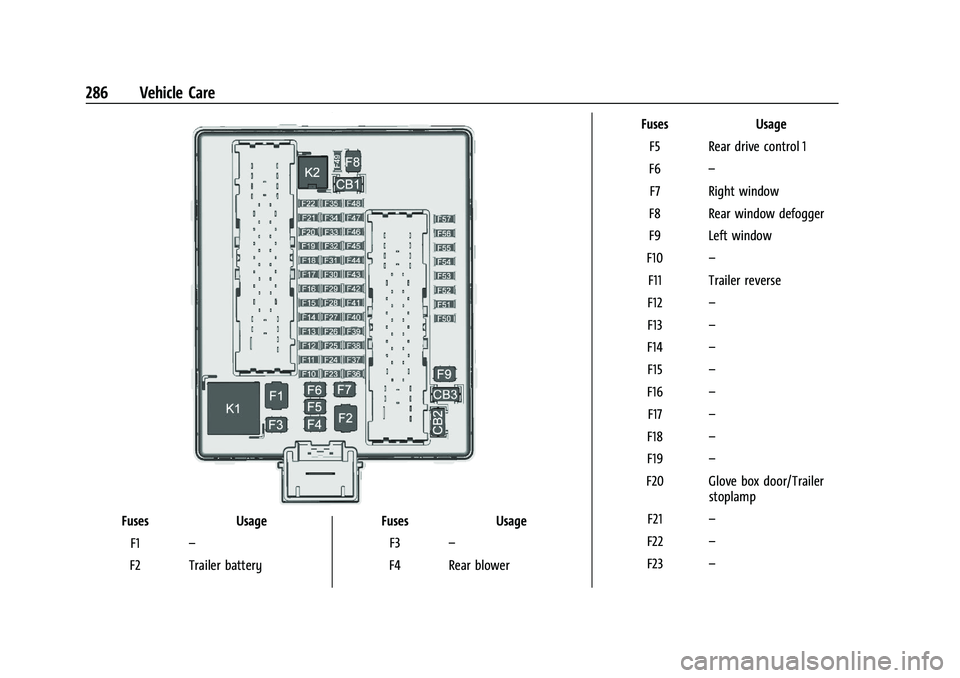
Chevrolet Blazer Owner Manual (GMNA-Localizing-U.S./Canada/Mexico-
14608203) - 2021 - CRC - 10/29/20
286 Vehicle Care
FusesUsage
F1 β
F2 Trailer battery Fuses
Usage
F3 β
F4 Rear blower Fuses
Usage
F5 Rear drive control 1
F6 β
F7 Right window
F8 Rear window defogger
F9 Left window
F10 β
F11 Trailer reverse
F12 β
F13 β
F14 β
F15 β
F16 β
F17 β
F18 β
F19 β
F20 Glove box door/Trailer stoplamp
F21 β
F22 β
F23 β
Page 288 of 380
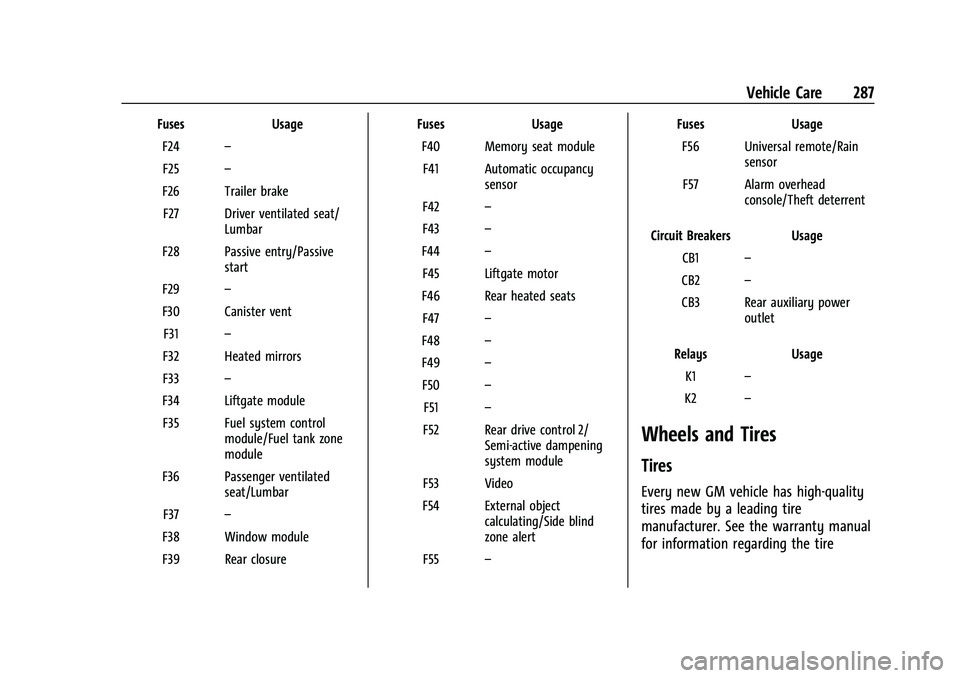
Chevrolet Blazer Owner Manual (GMNA-Localizing-U.S./Canada/Mexico-
14608203) - 2021 - CRC - 10/29/20
Vehicle Care 287
FusesUsage
F24 β
F25 β
F26 Trailer brake F27 Driver ventilated seat/ Lumbar
F28 Passive entry/Passive start
F29 β
F30 Canister vent F31 β
F32 Heated mirrors
F33 β
F34 Liftgate module F35 Fuel system control module/Fuel tank zone
module
F36 Passenger ventilated seat/Lumbar
F37 β
F38 Window module
F39 Rear closure Fuses
Usage
F40 Memory seat module F41 Automatic occupancy sensor
F42 β
F43 β
F44 β
F45 Liftgate motor
F46 Rear heated seats F47 β
F48 β
F49 β
F50 β
F51 β
F52 Rear drive control 2/ Semi-active dampening
system module
F53 Video
F54 External object calculating/Side blind
zone alert
F55 β Fuses
Usage
F56 Universal remote/Rain sensor
F57 Alarm overhead console/Theft deterrent
Circuit Breakers Usage CB1 β
CB2 β
CB3 Rear auxiliary power outlet
Relays Usage
K1 β
K2 β
Wheels and Tires
Tires
Every new GM vehicle has high-quality
tires made by a leading tire
manufacturer. See the warranty manual
for information regarding the tire
Page 289 of 380
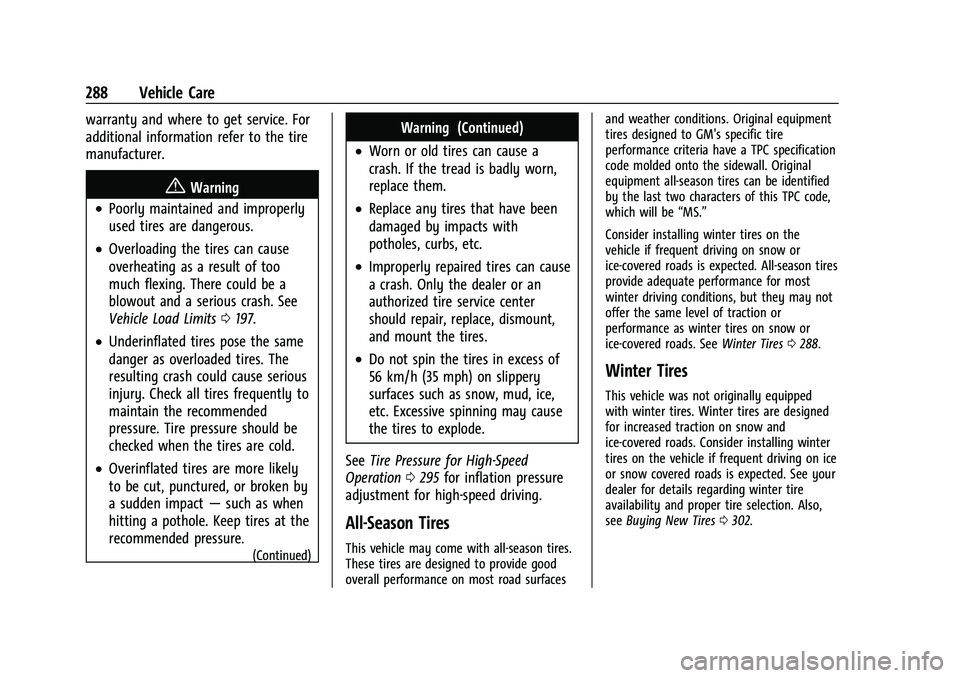
Chevrolet Blazer Owner Manual (GMNA-Localizing-U.S./Canada/Mexico-
14608203) - 2021 - CRC - 10/29/20
288 Vehicle Care
warranty and where to get service. For
additional information refer to the tire
manufacturer.
{Warning
.Poorly maintained and improperly
used tires are dangerous.
.Overloading the tires can cause
overheating as a result of too
much flexing. There could be a
blowout and a serious crash. See
Vehicle Load Limits0197.
.Underinflated tires pose the same
danger as overloaded tires. The
resulting crash could cause serious
injury. Check all tires frequently to
maintain the recommended
pressure. Tire pressure should be
checked when the tires are cold.
.Overinflated tires are more likely
to be cut, punctured, or broken by
a sudden impact βsuch as when
hitting a pothole. Keep tires at the
recommended pressure.
(Continued)
Warning (Continued)
.Worn or old tires can cause a
crash. If the tread is badly worn,
replace them.
.Replace any tires that have been
damaged by impacts with
potholes, curbs, etc.
.Improperly repaired tires can cause
a crash. Only the dealer or an
authorized tire service center
should repair, replace, dismount,
and mount the tires.
.Do not spin the tires in excess of
56 km/h (35 mph) on slippery
surfaces such as snow, mud, ice,
etc. Excessive spinning may cause
the tires to explode.
See Tire Pressure for High-Speed
Operation 0295 for inflation pressure
adjustment for high-speed driving.
All-Season Tires
This vehicle may come with all-season tires.
These tires are designed to provide good
overall performance on most road surfaces and weather conditions. Original equipment
tires designed to GM's specific tire
performance criteria have a TPC specification
code molded onto the sidewall. Original
equipment all-season tires can be identified
by the last two characters of this TPC code,
which will be
βMS.β
Consider installing winter tires on the
vehicle if frequent driving on snow or
ice-covered roads is expected. All-season tires
provide adequate performance for most
winter driving conditions, but they may not
offer the same level of traction or
performance as winter tires on snow or
ice-covered roads. See Winter Tires0288.
Winter Tires
This vehicle was not originally equipped
with winter tires. Winter tires are designed
for increased traction on snow and
ice-covered roads. Consider installing winter
tires on the vehicle if frequent driving on ice
or snow covered roads is expected. See your
dealer for details regarding winter tire
availability and proper tire selection. Also,
see Buying New Tires 0302.
Page 290 of 380
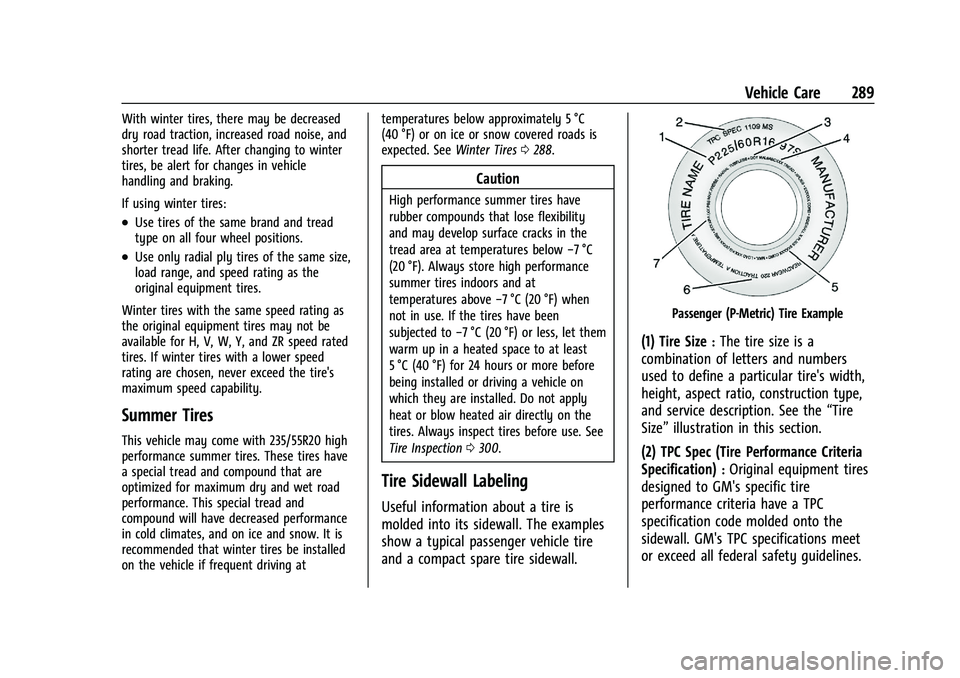
Chevrolet Blazer Owner Manual (GMNA-Localizing-U.S./Canada/Mexico-
14608203) - 2021 - CRC - 10/29/20
Vehicle Care 289
With winter tires, there may be decreased
dry road traction, increased road noise, and
shorter tread life. After changing to winter
tires, be alert for changes in vehicle
handling and braking.
If using winter tires:
.Use tires of the same brand and tread
type on all four wheel positions.
.Use only radial ply tires of the same size,
load range, and speed rating as the
original equipment tires.
Winter tires with the same speed rating as
the original equipment tires may not be
available for H, V, W, Y, and ZR speed rated
tires. If winter tires with a lower speed
rating are chosen, never exceed the tire's
maximum speed capability.
Summer Tires
This vehicle may come with 235/55R20 high
performance summer tires. These tires have
a special tread and compound that are
optimized for maximum dry and wet road
performance. This special tread and
compound will have decreased performance
in cold climates, and on ice and snow. It is
recommended that winter tires be installed
on the vehicle if frequent driving at temperatures below approximately 5 Β°C
(40 Β°F) or on ice or snow covered roads is
expected. See
Winter Tires0288.
Caution
High performance summer tires have
rubber compounds that lose flexibility
and may develop surface cracks in the
tread area at temperatures below β7 Β°C
(20 Β°F). Always store high performance
summer tires indoors and at
temperatures above β7 Β°C (20 Β°F) when
not in use. If the tires have been
subjected to β7 Β°C (20 Β°F) or less, let them
warm up in a heated space to at least
5 Β°C (40 Β°F) for 24 hours or more before
being installed or driving a vehicle on
which they are installed. Do not apply
heat or blow heated air directly on the
tires. Always inspect tires before use. See
Tire Inspection 0300.
Tire Sidewall Labeling
Useful information about a tire is
molded into its sidewall. The examples
show a typical passenger vehicle tire
and a compact spare tire sidewall.
Passenger (P-Metric) Tire Example
(1) Tire Size:The tire size is a
combination of letters and numbers
used to define a particular tire's width,
height, aspect ratio, construction type,
and service description. See the βTire
Sizeβ illustration in this section.
(2) TPC Spec (Tire Performance Criteria
Specification)
:Original equipment tires
designed to GM's specific tire
performance criteria have a TPC
specification code molded onto the
sidewall. GM's TPC specifications meet
or exceed all federal safety guidelines.